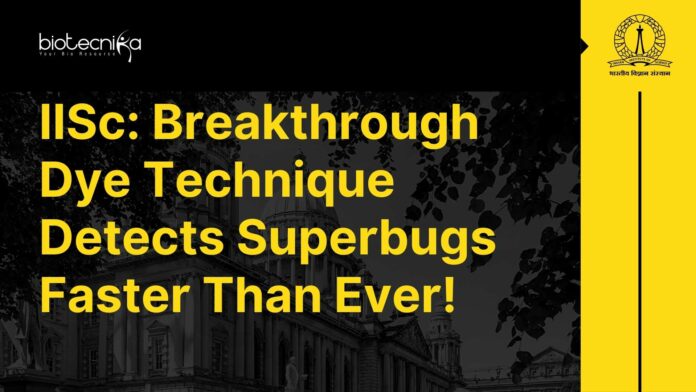Rapid Antibiotic-Resistance Detection Test by IISc
Breakthrough Dye Technique Detects Superbugs Faster Than Ever!
Antibiotics are crucial tools used to fight infections in humans, animals, and even in agriculture. But there’s a big problem: the overuse of these drugs has led to the rise of antibiotic-resistant bacteria, often called “superbugs.” These superbugs are becoming a global threat, causing millions of deaths each year because the antibiotics we have can’t kill them anymore.
Detecting these resistant bacteria quickly is vital for controlling the spread of infections. Traditional methods, like growing bacteria in the lab to see if they survive antibiotic treatment, take a long time—sometimes days. This delay can be dangerous, especially in critical situations. However, a new study from the Indian Institute of Science (IISc) offers a faster solution by using a special type of fluorescent dye.

This research was primarily conducted by Ashim Dubey, an undergraduate student in Dipankar Nandi’s lab at IISc, with collaboration from scientists at Jawaharlal Nehru University (JNU) and the Satya Sai Institute. The team developed a clever test that can tell whether bacteria are resistant or sensitive to antibiotics by observing changes in the bacteria’s cell membrane.
Here’s how it works: When bacteria are hit with antibiotics that are supposed to kill them, they often start releasing harmful molecules known as reactive oxygen species (ROS). These molecules can damage the bacteria’s membrane—the outer layer that protects the cell. The researchers used two fluorescent dyes, called 4AP-C9 and 4AP-C13, created by the team at JNU. Under normal conditions, these dyes enter the bacteria’s membrane at different depths. But when the membrane is damaged by antibiotics, the dyes end up at the same depth, causing a noticeable change in the light they emit.
By measuring these changes in fluorescence, the researchers can quickly determine if the bacteria are resistant or not. This method is much faster than traditional techniques, offering a new way to identify superbugs with high accuracy.
This study opens up exciting possibilities for the future, as it could lead to quicker and more effective treatments for infections, helping to save lives and prevent the spread of resistant bacteria.
REFERENCE:
Dubey AK, Sardana D, Verma T, Alam P, Chattopadhyay A, Nandini SS, Khamari B, Bulagonda EP, Sen S, Nandi D, Quantifying Membrane Alterations with Tailored Fluorescent Dyes: A Rapid Antibiotic Resistance Profiling Methodology, ACS Infectious Diseases (2024).
https://doi.org/10.1021/acsinfecdis.4c00249
LAB WEBSITE:






















